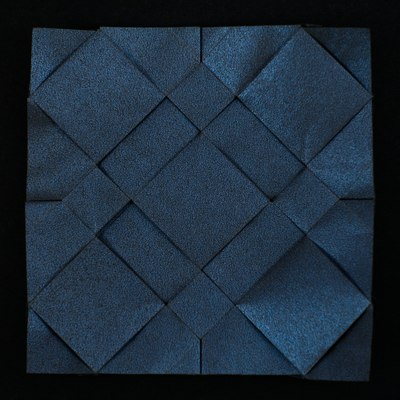Shadow Fold (Karaperapisu) Paper Review

Folding Composition of Squares I prompted me to review the paper whose Japanese name is Karaperapisu, but which I see people referring to as Shadow-Fold Paper more often for convenience.
First of all, this paper has beautiful appearance, which at the same time, makes it a bit hard to take a good picture of the model. One side of the paper (dark indigo in this case) is metallic and glittery with a delicate texture. The other side is matte and looks like regular tissue paper.
Shadowfold paper is thin but crisp and precreasing the model went well. It felt a bit like Nicolas Terry tissue foil but much softer and not as crisp (which is not necessarily bad since that paper’s crispness is a bit extreme). On both sides, creases are not too well visible, which may be an advantage for the looks of the model, but at times can even make folding difficult. Visibility depends on viewing angle, especially on the shiny side. For such a thin paper, I felt the difference in resistance when folding with and against paper grain to be very large.
Collapsing went well. There are a few tiny squash folds in the model on the back side, and I was not very happy with how the paper handled them, but it may be too small a sample to judge.
Overall, I think this paper is an interesting option for folding tessellations. It didn’t feel very strong, but I didn’t really have much opportunity to test its strength. Still, I’m not sure how well it would handle a more complex model with lots of precreasing. Nonetheless, it looks great, and is relatively thin which makes it suitable for a number of models. Maybe I can try folding a larger model from it some time in order to give it a more throughout test.
Comments